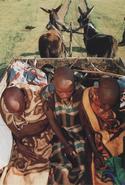Tswana Early Origins

Little is known about the early origins of the Sotho peoples of whom the Tswana now form part. According to oral tradition, they were among the Bantu-speakers who came from the vicinity of the East African Great Lakes - Victoria and Tanganyika, and made their way southwards in migrations over many centuries.
Tradition also has it that they were of a common stock and later broke up into various units. Like the Basotho, their settlement patterns and places of residence were affected by the wars of the early 1800s around the time of Shaka's rise to power.
Unlike the Basotho, they formed into separate chiefdoms, subsequently known as tribes in colonial parlance that persists in Botswana today, rather than a single one, and located themselves in the dry west of the country, where they found San people already taking refuge from pastoralist encroachment into their hunting areas.
Tswana Settlements
Among the earliest to settle in the eastern, fertile parts of present-day Botswana were the Kgalagadi. When the ancestors of the Rolong and Tlhaping settled along the upper reaches of the Molopo River and gradually moved south and west, they absorbed the Kgalagadi and San in the area.
Those who resisted incorporation were forced to move deep into the recesses of the Kalahari Desert where their descendants can still be found today. The area around modern-day Rustenburg, Zeerust and Lichtenburg in South Africa's North-West province was settled by Hurutshe, Kwena and Kgatla, whose settlements today reflect a strong Tswana presence. This presence is equally strong, but more dispersed and less obviously evident, throughout the cities of Gauteng province.
Evidence suggests that the ancestors of some of today's Tswana were living on the Highveld from at least the 17th century. The period from then until the early 19th century was marked by recurring political re-alignments and ruling-group fission: junior members of a chiefdom's ruling family often broke away with their followers to form a new group, which generally became known by the name of the new leader.
From about 1810, however, the trend was curtailed by two factors: the turmoil created by Nguni-speaking and other invaders during the Shakan wars; and the danger of land dispossession when white settlers came into the area, first in search of land and cattle and later in search of labour for the new diamond and gold mining industries.
Both factors threatened local chiefdoms' sovereignty and led to a new trend for denser settlement in larger defensive political units than previously. With political fission having become much more difficult and unsafe, existing chiefdoms grew larger and were consolidated, often around large village-like settlements, into what are today called tribes.